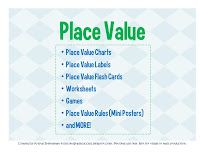This year I have been blessed with a wonderful new teaching partner! After preparing both the classroom (pictures later) and the pre-assessing students in reading (more here later too) we were ready to begin our centers and center rotations during reading. It takes tons of time and planning and preparation, but it is completely worth it to see reading grades climbing.
We have implemented eleven, that's right, eleven total centers this year:
1.
Teacher Time- Two groups at a time come to the reading table to practice fluency, comprehension, and phonemic awareness. Better yet--this counts as two centers!
2.
Spelling- One group at a time practices spelling words in their weekly spelling unit or practices completing word sort activities.
3.
Listening- One group at a time travels to this center and listens to a book on tape (ideally with headphones). After the students are used to listening the books at the center add response cards for comprehension and connection practice.
4.
Writing- This is a one group SILENT! center. Select appropriate grade level prompts and have students write a set number of sentences and then illustrate the story.
5.
Handwriting- This is another one group SILENT! center. Have students complete handwriting practice on dry-erase boards. There are great ones out there that have letters and strokes on them already. We also teach both manuscript and cursive, so we are completing two portfolios that will be completed at this center.
6.
Math- One group of students, flashcards, folder games, and even a fun worksheet are all that this center needs. Review an old concept and introduce a hard concept in a hands on way!
7.
Bible- Teaching a Christian school gives us a chance to reinforce biblical truth during reading. Students complete various activities such as placing the books of the Old Testament in order, read Bible stories, and play Bible games that we found at the Dollar Tree.
8.
Library- Leveled books in organized bins allow students to read book on their level, one level below their level, and one level above their level. Students are allowed to read to stuffed animals that are at the center. Every so often let the students do buddy reading.
9.
Word Building- In this center one group of students will practice building words, finding synonyms and antonyms, and working with parts of speech to build sentences.
10.
Poetry- This is the last center. After teaching poems/poetry as a whole class we are going to have students read poems and write a poem with the same pattern. After we feel they are getting the hang of reading and writing poems, we are also going to have them find the pattern!
11.
Reading- Have one group of students sitting at there desks reading and/or rereading the story you will be teaching during small group instruction. Assign phonics and easy comprehension pages for practice.
Helpful Hints for Centers:
- Use marble-lined composition books for journals in the Writing Center and the Poetry center, and one for anything else they may need to use paper for.
- Add centers slowly.
-Practice rotating from center to center without having the students do anything at that center.





